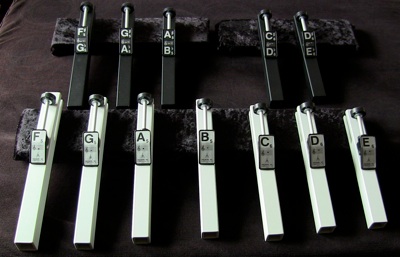There are special challenges to ringing chimes in solos. They are harder to pick up quickly than bells and require modification of multiple bell techniques. Continue reading Chimes in solo work
Category Archives: Technique
Interlocked six-in-hand
Holding three bells in each hand (called six-in-hand or 6IH) can solve certain ringing problems. For example, you may need to play an ostinato (repeating pattern) with more bells than you can comfortably play with four-in-hand, even traveling. Become proficient in four-in-hand before attempting six-in-hand. Having that experience will help you master the setup with an additional bell in hand, and you’ll find more uses for four-in-hand, anyway. It can take several months to master six-in-hand, though I hope the suggestions below, as well as the video tutorial, will shorten your learning curve. Continue reading Interlocked six-in-hand
Mallet technique: practice tips, advanced techniques
In this article, I’ll cover practice tips that apply both to bell trees and bells malleted on the table, and discuss how to solve common problems. Continue reading Mallet technique: practice tips, advanced techniques
Mallet technique: basics
See the article on Mallets for information on buying mallets and matching them to bells.
I strongly recommend scheduling some sessions with a professional percussionist to learn proper mallet technique. Ask around for a marimba instructor: call music stores that sell percussion instruments, contact the local music schools, and ask your musician friends for recommendations. There’s no substitute for hands-on instruction by a pro. Try to have someone come to where your bells are so you can work with your equipment, both trees and table bells. Second best would be to take your bell trees to your instructor’s studio. If neither will work, you can learn a lot using the instructor’s mallets and marimba, but you’ll be on your own transferring that knowledge to bells. Continue reading Mallet technique: basics
Movement and dynamics
In this article, you can read about:
• Picking up bells faster,
• Avoiding the Dreaded Banana,
• Creating basic dynamic effects,
• Increasing your range of motion,
• Cringe-worthy movement mistakes, and
• A secret. Continue reading Movement and dynamics
Reverse grips
This article assumes you understand the basics of Shelley ringing and four-in-hand “ring and knock.” Sometimes you have the bells in a pair set for the right hand, and the next time you approach that pair, your left hand is free. Rather than choreograph around the problem, learn how to pick up the pair with the other hand. There are several ways to do this, in addition to the method already covered in Interlocked four-in-hand. Continue reading Reverse grips
Interlocked four-in-hand
There are situations where standard four-in-hand configurations don’t work well. You may have to pick up a preset pair of bells even faster than usual, or at an uncomfortably long reach. Sometimes you have a pair set up for one hand and the next time you pick it up, it’s in the other hand. A bell handle may be too wide to grip between your index and middle finger, especially on Malmark bells or older Schulmerichs. You may find it tiring to hold a pair of bells slightly too large for your hand. In all these examples, interlocked four-in-hand is one possible solution. Continue reading Interlocked four-in-hand
Exchanging primary and secondary bells
This article assumes you understand the basics of Shelley ringing and four-in-hand “ring and knock.” Today’s topic is moving the primary bell to the secondary position, or vice versa. You would generally do this to create new four-in-hand pairs (either Shelley or ring-and-knock), because you need the bells grouped differently the next time you ring them. Often the best time to set that up is when you’re already holding one of the bells in a different four-in-hand configuration. Rather than explain all the possible combinations, which would be confusing, I’m going to introduce four different techniques, along with a few principles to apply them to different situations. Continue reading Exchanging primary and secondary bells
Alternate Shelley and combo ring
This article assumes you understand the basics of Shelley ringing and four-in-hand “ring and knock.” You generally use Shelley to ring two bells together, and set the clappers parallel. You use ring and knock to ring two bells separately, and set the clappers perpendicular. However, sometimes you want to ring two bells separately when they’re set up for Shelley, or you want to ring two bells together when they’re set up for ring and knock. You’ll have more choreography options if you learn alternate Shelley, where you ring one bell in Shelley configuration, and combo ring, where you ring and knock at the same time. Continue reading Alternate Shelley and combo ring
Special techniques
I try to have something interesting in every piece. Over the course of a concert, the audience acclimates to watching one person ring “all those bells,” so I unveil surprises to keep them engaged. Continue reading Special techniques
